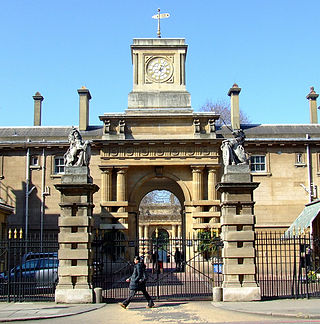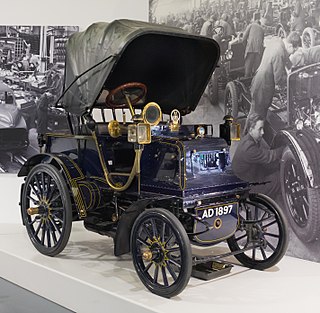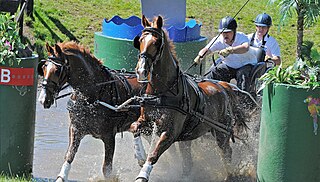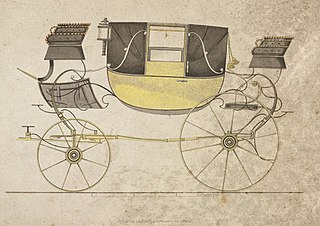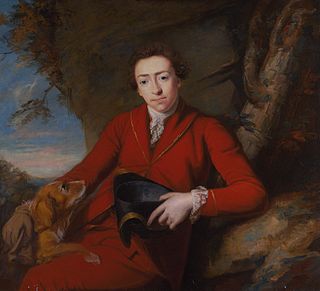Early British driving clubs
The B.D.C.
One of the first driving clubs was the Bensington Driving Club, founded in February 1807 at Bensington, Oxfordshire, also known as the Benson Driving Club when Bensington became Benson, and commonly referred to as "the B.D.C.". It was disbanded in 1854. [1] [2] [3] The BDC initially met in the White Hart public house. [4] Later the club was relocated to Bedfont, becoming the Bedfont Driving Club with ease (since the initials remained the same), and met in the Black Dog public house. [5] [6] As a consequence it was also known by the informal name the Black and White Club. [4]
Its first president was Charles Finch. [7] Finch's successor as president was Thomas Onslow, 2nd Earl of Onslow, a.k.a. "Tommy" Onslow. [8] The members of the club were illustrated in Holcroft's comedy The Road to Ruin in Goldfinch. [5] Tommy Onslow was ridiculed in two epigrams, the first of which was: [9]
What can Tommy Onslow do?
He can drive a coach and two!
Can Tommy Onslow do no more?
He can drive a coach and four.
The second was a variation:
Say, What can Tommy Onslow do?
Can drive a curricle and two!
Can Tommy Onslow do no more?
Yes, — drive a curricle and four.— [5]
In fact, these were variants of a rhyme that had followed Onslow from his days as a "whip" long before the founding of the Four-In-Hand Club, where he had driven a phaeton. In Athenaeum one correspondent reported that the verse had been popular in Onslow's younger days, in Surrey, at the start of the 19th century: [12]
What can little T. O. do?
Drive a phaeton and two.
Can little T. O,. do no more?
Yes, — drive a phaeton and four.— [5]
The Four Horse Club
The (friendly) rival Four Horse Club was founded the year after the BDC, in April 1808, but didn't last as long. [1] [3] [4] It was founded because the membership of the BDC was limited to 25 people. Charles Buxton, the inventor of the Buxton bit, along with some friends therefore founded the Four Horse Club. It was also informally known by various other names, as the Four-In-Hand Club (after four-in-hand), the Whip Club, and the Barouche Club. The third name was after a type of horse carriage called a barouche, which was driven by its members. The club rules dictated that a barouche should have silver mounted harnesses, rosettes at their heads, yellow bodies, "dickies", and bay horses. However, the final requirement was relaxed. Club members Sir Henry Peyton and Mr Annesley drove roan horses. [4]
The Four Horse Club rules also had strict dictates about clothing for the drivers. They required a drab coat that reached down to one's ankles, decorated with large mother-of-pearl buttons, and three tiers of pockets; a blue waistcoat with inch-wide yellow stripes; knee-length breeches with strings and rosettes, made of plush; and a hat that was at least 3.5 inch deep in the crown. [4] The Club regularly drove as a group to Salt Hill, where they spent a convivial evening and the night, before driving back to London. [13]
The FHC encountered difficulties in 1820, revived in 1822 with slightly different club rules, but only lasting until 1826. [1] [6] An 1820 joke went the rounds, of a person addressing a FHC member, saying "I hear that you men have broken up.". To which, the reply was "No. We've broken down; the FHC had not enough in hand to keep on with." [3] [6] The modified rules called for a brown landaulet carriage, without ornaments; no restrictions upon horse colour; and brass mounted harnesses. [6]
The Richmond Driving Club
The Richmond Driving Club was founded in 1838 by Lord Chesterfield. [14] [15] It only lasted until 1845. It used to meet at Lord Chesterfield's house, and drive, in procession, to dinner at the Castle Hotel in Richmond. It was satirized by Robert Smith Surtees: [15]
Following his track succeeds a numerous band,
Who vainly drive to work their fours-in-hand.
For Richmond bound I view them passing by,
Their hands unsteady, and their reins awry.
Some scratch their panels, some their horses' knees —
Beaufort and Payne, I class you not with these;
For who so smartly skins along the plain
as Beaufort's Duke? What whip can equal Payne?
No matter — dinner comes, when all are able
To drive their coaches well about the table.
Ricardo then can driving feats relate,
And Batthyany swear he'd clear the gate;
Till midnight closes o'er the festive scene,
Then who so bold as ride with Angerstein?
He who aloft can mark with unmoved nerve
The wheelers jibbing while the leaders swerve,
And sit, al careless, 'mid the wordy war
To lose a pinch-pin, break a splinter-bar.— Chaunt of Achilles, Surtees [15]

The Duke of Beaufort, named in the poem, did take part in the processions, but was not actually a member of the RDC. Mr Angerstein, also named, was a particularly reckless driver, whose reputation led no-one to want to ride with him. An anecdote relates that on one occasion someone unwittingly climbed into Angerstein's carriage after dinner for the ride home. Angerstein, so excited that someone had actually chosen to ride with him, set off immediately, without waiting for the rest of the procession, and so suddenly that his passenger was thrown head-over-heels. The passenger, realizing whose carriage he had embarked upon, saying nothing jumped straight off. [15]
The Four-In-Hand Driving Club
The Four-In-Hand Driving Club was founded in 1856. [16]


